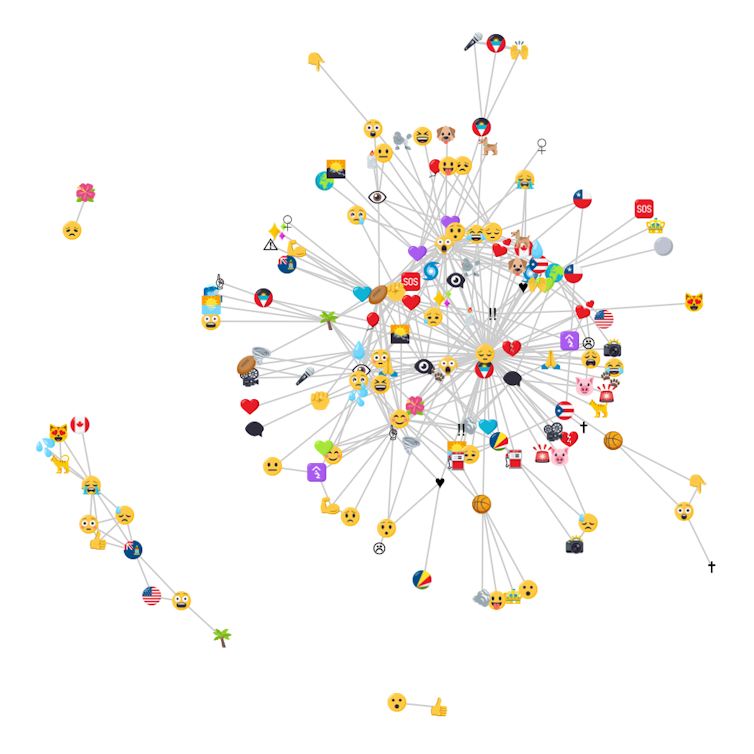Understanding the emoji of solidarity
- Written by Sashank Santhanam, Ph.D. Candidate in Computer Science, University of North Carolina – Charlotte
When disaster or tragedy strikes, people far away are touched and want to help – but really can’t do much. Often the first thing distant observers do is take to social media to send their thoughts, prayers, support and good wishes for survivors, rescue workers and others affected. And a lot of times, those online posts involve emoji – as well as hashtags in the poster’s own language, and other languages.
First created in the late 1990s, emoji became prominent worldwide in 2015 when the Oxford Dictionaries named the “face with tears of joy” emoji ? the word of the year[1]. Social media posts often use emoji because they are so expressive in so few characters. Combining emoji with text can be a very efficient way to communicate.
Our research analyzed emoji and their accompanying text to identify how people used emoji to express solidarity on Twitter during two crises[2], the November 13, 2015, terror attacks in Paris[3] and the destruction wrought by Hurricane Irma in August and September 2017[4]. The existing research on emoji use hasn’t looked at how people communicate support on social media. We were able to quickly see that rather than depictions of the person having an emotional reaction, most tweets expressing solidarity included non-face emoji.
Showing support
Non-face emoji can help clarify readers’ perceptions of the message[5]. As the Paris attacks unfolded, the most common support emoji were flags of different countries like Russia ??, the U.K. ?? and the U.S. ??, alongside the French flag ??. These, we know, were from people in other countries sending their thoughts to those affected in France. Other related emoji didn’t express solidarity, but conveyed what was happening: Tweets around the Paris attacks used ? and ☎️ to indicate danger and information.
For the Hurricane Irma event, solidarity was expressed with the help of different kinds of hearts, like ❤️ and ?. A unique characteristic of solidarity during Hurricane Irma event expressed concern for the animals affected, like ?, ? and ?. Flag emoji were not as prominent as during the Paris attacks.
Co-occurring emoji
Often people use emoji paired together. During the Paris attacks, for instance, people sending love to France posted the ??❤️ pair. During Hurricane Irma, people sending thoughts and love posted the ?❤️ emoji from afar. People in regions affected by the storm often posted the ?? pair.
 A network diagram shows how people from outside the affected regions used pairs of emoji to express emotions about Hurricane Irma.
Santhanam et al., CC BY-ND[6][7]
A network diagram shows how people from outside the affected regions used pairs of emoji to express emotions about Hurricane Irma.
Santhanam et al., CC BY-ND[6][7]
By contrast, during Hurricane Irma, the most commonly used emoji pairs in tweets from from outside the storm’s area included the sorrow emoji ? with either the flag of Antigua and Barbuda ?? or Cuba ??.
As both events unfolded, tweets carried a steady stream of positive emoji, like ? and ?, which continued into the days afterward. Negative emoji, like ? and ?, on the other hand, peaked at key points – as Hurricane Irma moved closer to the U.S., and during the night of the Paris attacks – but disappeared almost completely afterward.
Documenting how people use emoji to communicate about large disasters offers a new window into human behavior, including how it evolves over time and across the world. In the future, we hope to explore emoji use in connection with collective social movements like #MeToo[8] and #MarchForOurLives[9].
References
- ^ word of the year (en.oxforddictionaries.com)
- ^ solidarity on Twitter during two crises (ceur-ws.org)
- ^ November 13, 2015, terror attacks in Paris (www.theguardian.com)
- ^ Hurricane Irma in August and September 2017 (www.nola.com)
- ^ help clarify readers’ perceptions of the message (doi.org)
- ^ Santhanam et al. (ceur-ws.org)
- ^ CC BY-ND (creativecommons.org)
- ^ #MeToo (theconversation.com)
- ^ #MarchForOurLives (theconversation.com)
Authors: Sashank Santhanam, Ph.D. Candidate in Computer Science, University of North Carolina – Charlotte
Read more http://theconversation.com/understanding-the-emoji-of-solidarity-99711

